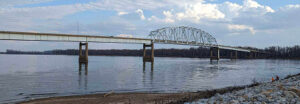As the Trump Administration reviews federal grant priorities and timelines, we encourage those working on project proposals to reach out to federal and state program leads and monitor official federal channels for the latest guidance. AFC is tracking key flooding and resilience programs and will provide specific updates whenever possible. On April 4, 2025, FEMA announced that it is ending the Building Resilient Infrastructure and Communities Program and cancelling all BRIC applications from Fiscal Years 2020 – 2023.
FEMA’s pre-disaster BRIC grants fund projects to protect property and infrastructure from flooding, support capacity-building for project planning, partnerships, and building code implementation, and provide technical assistance for effective mitigation and high-quality applications.
| Supports nature-based solutions | Targeted support for small communities | ||
| Encourages public-private partnerships |
Application cycle: As of February 13, 2025, the Notice of Funding Opportunity for this program has been removed from the grants.gov website, and FEMA announced on April 4, 2025, that it is ending the BRIC Program. The previously published application cycle was January 6, 2025 – April 18, 2025 for states; local governments submit mitigation planning and project applications to their state during the open application cycle, which may occur before the deadline set for states.
Summary: FEMA’s Building Resilient Infrastructure and Communities (BRIC) program provides funding for public infrastructure projects and mitigation efforts that bolster a community’s flood resilience before a disaster strikes.
Eligible applicants: Eligible states, territories and federally recognized tribal governments can submit applications on behalf of subapplicants for BRIC funding. Subapplicants cannot submit these directly to FEMA; subapplicants must submit them to their applicant for review and submission. Homeowners, business operators and nonprofit organizations cannot apply directly to FEMA; they can be included in a subapplication submitted by an eligible subapplicant.
Eligible activities: FEMA provides the following uses of assistance through the BRIC program:
- Capability and capacity-building (C&CB) activities: Activities that enable recipients to identify mitigation actions and implement projects that reduce risks posed by natural hazards. Eligible activities include project scoping, partnerships, mitigation planning and planning-related activities, and adoption and implementation of building codes.
- Mitigation projects: Projects designed to increase resilience and public safety, reduce injuries and loss of life, and reduce damage to property, critical services, facilities, and infrastructure from flooding. Examples include property acquisition and structure relocation, structure elevation, mitigation reconstruction, dry floodproofing of historic residential structures, dry floodproofing of non-residential structures, generators, and structural and non-structural retrofitting of existing buildings.
- Management costs: Funding to reimburse the recipient for eligible and reasonable indirect costs, direct administrative costs, and other administrative expenses associated with a specific mitigation project or C&CB activity.
- Non-financial direct technical assistance: Non-financial assistance to build a community’s capacity and capability to improve its resilience to flooding and ensure stakeholders can build and sustain successful mitigation programs, submit high-quality applications, and implement new and innovative projects that reduce flood risk.
Funding:
- National Competition Maximum: $451 million.
- State/Territory Allocation: $112 million.
- Filter — Targeted Support for Tribal Communities: Tribal Set-Aside: $50 million (includes $25 million for Tribal Building Code Plus-Up activities). The combined cost of the applicant’s capability- and capacity-building activities under this must not exceed $2 million. Up to $1 million of the Tribal Set-Aside may be used for hazard mitigation planning and planning-related activities per applicant.
- State/Building Code Plus-Up: $112 million.
Cost share:
- 75% federal / 25% local.
- 90% federal / 10% local, for Economically Disadvantaged Rural Communities, also known as small impoverished communities, defined as communities of 3,000 or fewer individuals with residents having an average per capita annual income not exceeding 80 percent of the national per capita income.
- 100% federal / 0% local, for management costs.
- Insular areas may receive a full waiver if the non-federal cost share is below $200,000.
- Filter — In-Kind Contributions: The nonfederal cost share may consist of cash, donated or third-party in-kind services, materials, or any combination thereof.
- Filter — Needs-Based Cost Sharing: Federal cost share of up to 90% federal /10% local for communities with less than 3000 individuals, and average per capita income of less than 80% of the national per capita income.
- Filter — Public Private Partnerships: FEMA encourages innovative use of public and private-sector partnerships to meet the non-federal cost share.
Application process:
- The 2025 application cycle opens on January 6 and closes on April 18, 2025 (3:00 p.m. ET) for states, tribes, and territories. Local governments submit mitigation planning and project applications to their state during the open application cycle. Local governments should contact their State Hazard Mitigation Officer or federally recognized tribal or local government official for more information. Identify your state officer online.
- Eligible Applicants must apply for funding using the FEMA Grants Outcomes (FEMA GO), which is now the management system for BRIC.


